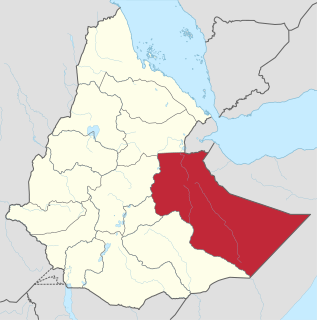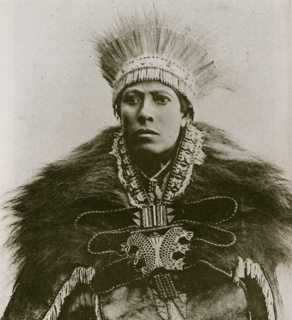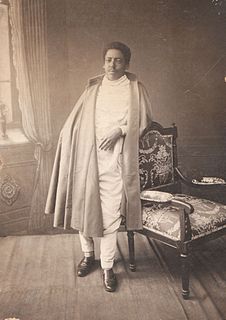
Lij Iyasu was the designated Emperor of Ethiopia from 1913 to 1916. His baptismal name was Kifle Yaqob. Ethiopian emperors traditionally chose their regnal name on the day they were crowned, and since he was never crowned, he is usually referred to as Lij Iyasu, "Lij" meaning child, especially one born of royal blood.
Lorenzo Taezaz was an important diplomatic official for Ethiopia. He served as Emperor Haile Selassie's diplomatic representative during the Emperor's exile in Britain following the Second Italo-Ethiopian War, being the permanent delegate from Ethiopia to the League of Nations. After the restoration of the Ethiopian government, Lorenzo was Minister of Foreign Affairs, Minister of Posts and Telegraph, and served in the Ethiopian Senate.

Hararghe was a province of eastern Ethiopia with its capital in Harar.

Blatten Geta Heruy Welde Sellase was a Foreign Minister of Ethiopia and a writer in Amharic. Bahru Zewde observes that his career "stands out as the great success story ... of the early twentieth-century intellectuals," then continues, "His prolific literary record, his influence with Tafari-Hayla-Sellase and his ascent in the bureaucratic hierarchy were all characterized by an unchequered progression. Edward Ullendorff concurs in this evaluation, describing his oeuvre as "a considerable and distinguished literary output."
Tekle Wolde Hawaryat was an Ethiopian politician. Anthony Mockler describes him as "the only contemporary of Haile Selassie who throughout a long life was always prepared to come out in open opposition to him."
Wolde Giyorgis Wolde Yohannes was an important government Minister during the reign of Haile Selassie. Between 1941 and his downfall in 1955, he came to dominate Ethiopian politics for a decade and a half, not only serving as Tsehafi Taezaz or Minister of the Pen (1941–1955), but at times Minister of the Interior (1943–1949), and Minister of Justice (1949–1955).

DejazmachBalcha Safo Amharic: ባልቻ ሳፎ; 1863 – 6 November 1936), popularly referred to by his horse-name Abba Nefso, was an Ethiopian military commander and lord protector of the crown, who served in both the First and Second Italo-Ethiopian Wars.

Tekle Hawariat Tekle Mariyam was an Ethiopian politician, an Amhara aristocrat and intellectual of the Japanizer school of thought. He was the primary author of the 16 July 1931 constitution of Ethiopia, which was influenced by the Japanese Meiji Constitution.

The Ministry of Defense is a cabinet-level office in charge of defense-related matters of Ethiopia. It oversees the Ethiopian National Defense Force and Ethiopian Defense Industry. The current minister is Abraham Belay.
Hailu Tekle Haymanot, also named Hailu II of Gojjam, was an army commander and a member of the nobility of the Ethiopian Empire. He represented a provincial ruling elite who were often at odds with the Ethiopian central government. Hailu Tekle Haymanot was an independent-minded potentate who, throughout his life, was mistrustful of and mistrusted by the Emperor.

Tekle Haymanot Tessemma, also known as Adal Tessemma, Tekle Haymanot of Gojjam, and Tekle Haimanot of Gojjam, was King of Gojjam. He later was an army commander and a member of the nobility of the Ethiopian Empire.
Nasibu Zeamanuel, also Nasibu Zamanuael or Nasibu Emmanual in some texts, was an army commander of the Ethiopian Empire. Along with his brother Wasane, historian Bahru Zewde groups Nasibu "among the most colourful of the first-generation intellectuals" of Twentieth-century Ethiopia. His maternal grandfather, Azaz Emmanual Wolde Malakot, whose name both brothers came to adopt, was a notable courtier of Emperor.

Emperor Haile Selassie proclaimed a revised constitution in November 1955 of the Ethiopian Empire. This constitution was prompted, like its 1931 predecessor, by a concern with international opinion. Such opinion was particularly important at a time when some neighboring African states were rapidly advancing under European colonial influence and Ethiopia was pressing its claims internationally for the incorporation of Eritrea, where an elected parliament and more modern administration had existed since 1952.

Ethiopia–Japan relations are the international relations between Ethiopia and Japan. Before the Second Italo-Ethiopian War the Japanese worked towards economic goals with the Ethiopians in attempts to expand Japan's trade with the rest of the world.
The Black Lions were an anti-fascist resistance movement formed to fight against Italy during the occupation of the Ethiopian Empire in the Second World War.

General elections were held in Ethiopia between 1 and 30 September 1957, to elect 210 members of the Chamber of Deputies, the lower house of the Ethiopian parliament. These elections followed the new constitution which had been enacted by Emperor Haile Selassie in 1955, and were the first ever held in that ancient country.
Yilma Deressa was an Ethiopian politician. He served as Finance Minister (1957–1970) and Minister of Foreign Affairs (1958-1960), Ambassador to the United States, and member of the Ethiopian Senate. John Spencer includes him in his list of five public figures who occupied the most important posts for the two decades following the Second World War.

LijSeifu Mikael was an Ethiopian noble, member of the Solomonic dynasty, belonging to the aristocratic Amhara family from Ankober Shewa. He was the grandson of Dejazmatch Mekuria Tesfaye of Menz, a prominent general and a cousin of Emperor Menelik II of Ethiopia. A public figure, educated in Paris at Sorbonne; one of the first few nobles who started paying salaries to their household servants advocating freedom of slaves and an avid supporter of Ras Tafari in his bid to become an emperor of Ethiopia. He served as Ethiopia's minister to France and Germany while he lived in Europe in the 1910s, Ethiopia's Consul General to Eritrea from 1921 to 1925 and Governor of several districts till the eve of the fascist invasion of Ethiopia.
Balabat was a largely traditional Ethiopian social class of wealthy land owners who lived on rent collected from their tenant framers (gebbars). Balabats were below the Mesafint and equal to the Mekwanint in the class hierarchy. They were closely related to, commonly married to, and had the same economic base on land as the Mesafints and Mekwanints. Balabats officially ceased to exist when feudalism was abolished in 1975.










